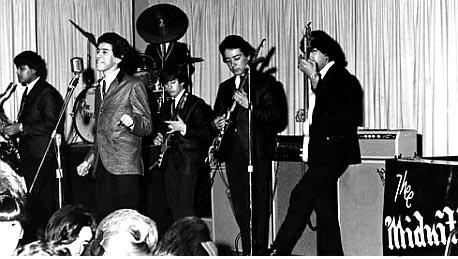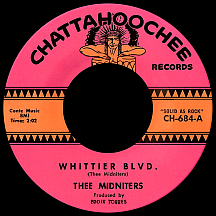THEE MIDNITERS
Whittier Blvd.
Whittier Boulevard isn't just any stretch of pavement known for cruising, boozing, using and trying to impress the opposite sex on weekend nights. In the 1960s it was the place to be...or I could say "Thee" roughly 20-mile loop spanning the eastern Los Angeles area where anyone could join the party-on-wheels from the comfort of their tricked-out, clean machines while prompting the police to closely monitor proceedings. As a native of Montebello, I know the drill. It was a ritual played out on Main Streets across America, though Whittier Boulevard has become perhaps the nation's most notorious route, as throngs of teens and twenty-somethings have traversed the major south-to-east arterial that stretches through the cities of La Habra, Whittier, Pico Rivera, Montebello, on through East L.A. and into the big city at the L.A. River, participating in a slow, low-riding parallel to what was going on not too far away in Malibu, Venice or Huntington Beach, where hot rods and hemis defined a fast-car culture (represented musically by Jan and Dean, The Beach Boys, The Rip Chords and others). The "East Side" lowriders were, by and large, Mexican-American, and their '60s musical heroes included The Premiers, The Blendells and the band known as Thee Midniters, creators of the L.A. street-cruising culture's instrumental theme song with an all-too-obvious title: "Whittier Blvd."
Willie Garcia was the main Midnighters man (note the different spelling of the band's name), who supplied the identifiable lead voice, though at first they were known as Benny and the Midnighters (according to Garcia, or Little Willie G., the name by which he's most fondly remembered, Benny Ceballos hauled the band's equipment around in his pickup truck and figured it was enough to warrant star billing). Early members of the usually-eight-man outfit included lead guitarist George Dominguez and rhythm guitarist Roy Marquez, both of whom, along with Garcia, attended Salesian High School in East L.A. The rest of the lineup came from nearby schools; there was organist Ronny Figueroa and a two-man horn section with a big sound, trombonist Romeo Prado and saxophonist Larry Rendon (these brass specialists had been in a band called The Gentiles with Garcia). Jimmy Espinoza, formerly with instrumental surf band The Vesuvians, played bass (replacing early member Benny Lopez, who'd been a member of Johnny and the Crowns, led by Johnny Gamboa). Danny LaMont (from my alma mater, Montebello High School) was the hard-driving drummer (he'd replaced George Salazar). At first they hit the stage wearing Lone Ranger-style party masks, but the novelty quickly wore thin.
Lil' Ray (born Ray Jimenez in Delano, California) was already a star in East L.A. with about a half-decade of experience playing local venues. In early 1964 he released a single with the Premiers ("Shake! Shout! & Soul!"), followed by "Loretta" (an uptempo doo wopper he'd written) with credited backing by the Midnighters (still pre-spelling change). Both singles were on Impact, a label distributed by disc jockey Art Laboe's Original Sound Records. Bob Keane of the Del-Fi and Donna labels had worked with Mexican-American artists (besides Ritchie Valens, he'd discovered Rene and Ray, who reached number two in L.A. with the 1962 single "Queen of My Heart"). Eddie Davis and Billy Cardenas went so far as to search for neighborhood bands with a radio-friendly sound; their plan was to build a Chicano music scene not unlike Britain's rock movement or, perhaps, something closer to what Berry Gordy had achieved with the Motown family of artists in Detroit. Cardenas personally managed and looked after several of the more prominent East L.A. acts of the mid-'60s.
In October 1964, the Midnighters were scheduled for a concert at East Los Angeles College (located in Monterey Park), where they did a six-minute version of Chris Kenner's 1963 R&B hit "Land of a Thousand Dances," already a staple of competing bands' live sets. The East L.A. versions differed from Kenner's New Orleans original with the addition of a 'Na-na-na-na-na' refrain (most likely originated by Ronnie and the Pomona Casuals, one of the first neighborhood bands to perform the song live); Willie G.'s Midnighters vocal featured a maniacal scream and the crowd in attendance went wild...like, smaller-scale Beatlemania wild! Tape was rolling and Cardenas wasted no time in shopping it around to labels. Ruth Conte Yardum, owner of Chattahoochee Records (the label had scored a major hit earlier in the year with "Popsicles and Icicles" by The Murmaids), picked up the master and split it into two parts for single release. This was when the change took effect in the band's name, mainly to avoid possible legal entanglements with Hank Ballard's hitmaking group the Midnighters. "Thee" was common slang on the East Side to designate someone as the "first" or "only." Thus, Thee Midniters became the definitive name for East L.A.'s hottest rock band, regardless of what Ballard had to say about it!
The single was issued in December (some copies had "Part I" flipped with a short, snappy instrumental, "Ball O' Twine"), but by January, when L.A.'s powerhouse top 40 stations KRLA and KFWB started to play it, "Land of 1000 Dances" by neighboring group Cannibal and the Headhunters (also a live performance) had appeared as competition, though both were top ten radio hits by early February; while Thee Midniters' version had broken first in a few scattered markets near the end of 1964 (it hit number one in a couple of spots), Cannibal's became the bigger hit across the U.S., making the top 30 in April. Thee Midniters' 45 did manage a brief Hot 100 run, their only single to do so.
Eddie Torres took over as Thee Midniters' manager, producing their sessions while working hard to book gigs all over Southern California, from large venues to small gatherings (which accounts for how I saw them in a local shopping center parking lot at a very young age and again some years later, during the ordeal I call high school, performing at a private party). Torres set up a "home base" inside the Golden Gate Theater at the corner of Whittier and Atlantic Boulevards, where the eight-man band was photographed, under the marquee, for the cover of their self-titled debut LP. They played frequently at local auditoriums like the Big Union Hall in Vernon, the Little Union Hall in Commerce, the Montebello Ballroom, the Paramount Ball Room in Boyle Heights and Pomona's Rainbow Gardens, and often appeared at the Hollywood Palladium as well as the Rhythm Room in Fullerton, where The Premiers famously (but hadn't actually) recorded "Farmer John," the 1964 hit that gave the go-ahead sign for all the other Chicano bands to start beating the doors down. And there's one more, the top spot: the El Monte Legion Stadium, where huge multiple-artist concerts took place and the East Side's finest were well-represented.

The next single by Thee Midniters was "Sad Girl," which had been a minor 1963 hit for soul singer Jay Wiggins and quickly became a staple of the band's shows as they turned more ballad-heavy, catering to the romance that was in the air as a result of their shows becoming essential date-night destinations. But the wildest single yet was destined to be the most famous Midniters song, regardless of its scarcity on Billboard's charts (you'll find it there, if you look with the help of a fine-tooth comb). Not a lot of sweat went into making "Whittier Blvd."...it was a loose jam session that worked...big time! The band: 'Let's take a trip down Whittier Boulevard...' (honk, honk)! Ronny F. (more deranged than it's possible to convey in print): 'Arriba-riba! Ah-haha-ha-ha-ha-ha!!!' The instrumental, with a killer horn arrangement by Prado, celebrated the popular pastime of cruising down the main drag and was a surprise hit, going top ten in L.A. in June 1965. For obvious reasons it didn't catch on in many places outside Southern Cal (though it was a hit in Chicago, perhaps because of its similarity to "2120 South Michigan Avenue," the Windy City/Chess Records tribute disc from the previous year by Midniters heroes The Rolling Stones). The song has remained a staple of L.A. oldies stations (no mean feat in this age of narrow playlists), due largely to a fierce loyalty among L.A.'s Mexican-American listeners, and their families, when it comes to the "oldies but goodies" of the '50s and '60s.
Their late-'65 cover of the Stones' "Empty Heart" and a remake of "That's All" (penned by Bob Haymes and Alan Brandt, it had been a Nat "King" Cole B side in '53 and a hit for Rick Nelson in '63) were added to the group's list of greatest hits, if only among the Latino population and the growing sphere of collectors. KRLA's Casey Kasem (and host of Shebang on KTLA channel 5, where Thee Midniters had been guests) booked the group for a big show at the Rose Bowl in Pasadena starring Herman's Hermits, The Turtles, The Bobby Fuller Four and many others; it was a big deal for the East Side octet, though a fraction of the thrill Cannibal and the Headhunters must have felt when they were invited that summer to open for The Beatles' second U.S. concert tour.
In late 1965, Eddie Torres formed Whittier Records (with its cartoonish label image of a vintage car cruising the street) primarily for Midniters releases. "Love Special Delivery" (its title making a subtle L.S.D. drug reference) came on like gangbusters with another hot Prado horn arrangement and urgent vocal by Willie G., a combination irresistible to the area's top 40 programmers (at KRLA, KFWB, newcomer/competition-crusher KHJ and wannabe player KBLA), who made it a top 30 hit in the summer of 1966. Many Whittier label singles, while going unnoticed in most of the world, were strong sellers in the area with or without airplay (Carlos Reyes, the owner of my junior high-through-teens hangout, the Sounds of Music record store located on - where else? - Whittier Boulevard, had a tough time ordering enough copies to meet demand). These include eastside favorites "It'll Never Be Over For Me," Solomon Burke's "Everybody Needs Somebody to Love," "Jump, Jive and Harmonize" and the anthemic, mostly-instrumental jam "Chicano Power," issued on Whittier in 1967 and later on La Raza ("The Race") Records. A few other acts had singles on Whittier; one example is deejay and concert host Godfrey's '67 rap routine "Down Whittier Blvd.," with backing by the band he'd so often introduced.
Jimmy Espinoza took over as the group's manager at about the time Willie Garcia called it quits, in effect leaving the band without its signature sound. There was one single on Uni Records, "She Only Wants What She Can't Get." Willie and Lil' Ray Jimenez formed a group, God's Children, in the early 1970s. Later, Willie became a heavy user of drugs and alcohol, touching close to rock bottom; he has since become a minister and any singing tends to be spiritual. His former bandmates are still kings in East L.A.; they've continued with various lineups always including no less than one or two original members. As for me, whenever I return to L.A. for a visit, which is fairly often, the sounds of the area's many Chicano groups, particularly Thee Midniters with Willie G.'s great vocals and Romeo Prado's distinctive horn arrangements, seem to emanate from the hills surrounding the Los Angeles basin. I don't feel that kind of vibe anywhere else my travels take me. But then, it's where I grew up.


